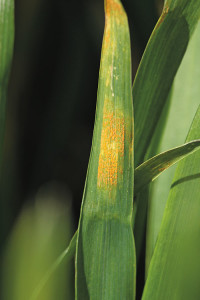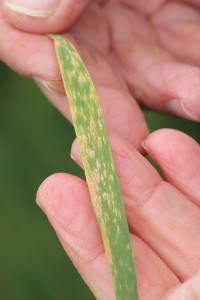Septoria crosses east-west wheat disease divide
Disrupted spray programmes and high disease pressure means growers should use the best chemistry and ensure they hit key yield-building leaves with remaining fungicide applications.

Signs of yellow rust infection
The Crop Doctor experts toured England again last week and found septoria “as bad as it could be” in Herefordshire and Lincolnshire, while the disease also loomed large in Yorkshire and to a lesser extent in Oxfordshire.
Yellow rust – largely absent at the time of the last tour – was also showing signs of a resurgence in susceptible varieties such as Reflection, along with eyespot and mildew.
Scotland Rural College’s Fiona Burnett says at Callow, just south of Hereford, high septoria pressure is “a given”, but she was surprised by levels in untreated plots at Long Sutton, on the edge of the Wash.
See also: Group 2 wheats deliver quality and a premium
“It couldn’t be much worse at those two sites, with disease already quite high up the canopy. Considering the time it takes for the disease to express itself, it has been there a while, so you know it is present in the rest of the crop,” she adds.
Adas’ principal research scientist Jonathan Blake agrees and says there is surprisingly little difference in septoria pressure at Long Sutton and Callow, which crosses the typical east/west divide for the wet-weather disease.
Watch the 2016 Crop Doctor video playlist including the summary of the T2 tour.
Mr Blake notes the septoria latent period at current temperatures is about three to four weeks and with disease established and expressing itself, infection must have occurred some time ago.
“As such, what is visible is only part of the infected leaf area, as there has already been transmission to leaves four and then three.
Actives
- Adexar: epoxiconazole + fluxapyroxad
- Aviator: bixafen + prothioconazole
- Imtrex: fluxapyroxad
- Keystone: epoxiconazole + isopyrazam
- Librax: metconazole + fluxapyroxad
- Proline: prothioconazole
- Rubric: epoxiconazole
- Seguris: epoxiconazole + isopyrazam
- Torch: spiroxamine
- Tracker: boscalid + epoxiconazole
- Vertisan: penthiopyrad
“Over the next few weeks there is also a risk of spread to leaf two and the flag, which are key yield-building leaves,” he says.
Timings awry
Worrying for growers in some parts of the country, given the high disease pressure, is late crop development and weather-interrupted T0s and T1s in the past few weeks.
In Yorkshire, it is estimated only 20% of T1s were applied by 28 April and many crops were still 10-14 days away from the leaf three T1 target emerging.
In the West, it is a similar story, with an even smaller proportion of T1s applied due to catchy weather halting sprayers and cold conditions slowing emergence of leaf three.
By the time Farmers Weekly is published, many growers will hopefully have applied some disease protection to exposed crops, but backward fields may still be waiting.
“If any T1s are still outstanding or delayed, use SDHI chemistry where possible to get the most activity on disease and try to keep leaf three as clean as possible,” says Mr Blake.
With eyespot evident at every site in susceptible varieties such as Britannia, Mr Blake advises where T1 haven’t been applied, growers should check crops and use Tracker or a prothioconazole-based product to control it.
Watch mildew

Symptoms of mildew infection
Mildew could also be problematic in late-sown crops of weak varieties such as Leeds, which will race through growth stages once the weather warms, producing soft and disease-susceptible growth.
Prof Burnett noted mildew on stems at Callow. He says for many crops it won’t be a problem, but in known hotspots or with susceptible varieties such as Leeds – grown widely in the North – it will need watching closely.
“If you are in that situation, a specific mildewicide such as cyflufenamid might be necessary, but SDHIs have some activity and so does prothioconazole, so if it’s used in the programme, that should be more than adequate to protect against it,” she adds.
Between now and flag leaf emergence, Prof Burnett also gives a yellow rust warning, with the disease present across the regions and able to cycle much faster than septoria.
As a result, it can often “pop up in the gap between T1 and T2″ and catch growers out, she explains. “I’m not a fan of a T1.5, but there may be a case for taking action if you have to get rid of yellow rust.
“A strobilurin plus spiroxamine would be ideal for azole resistance management, but if it was my crop, I wouldn’t take the risk.You may need a Torch, strobilurin plus azole mix to eradicate it,” she explains.
T2 timing
Looking ahead, both Mr Blake and Prof Burnett agree flag leaf sprays should be based on three-way mixes of SHDIs, azoles and multisite actives such as chlorothalonil, where possible.
The flag leaf spray is where the largest yield response to SDHIs is seen and with leaf two exposed for a period between T1 and T2, they offer the best kick-back and chance to quell latent disease.
Mr Blake says a good range of products is available, with bixafen and fluxapyroxad offering the best curative activity – it is the top choice on disease-susceptible varieties.
He notes as a protectant, isopyrazam – contained in products such as Seguris and Keystone – also offer a good choice, particularly on more resistant varieties.
“Vertisan isn’t talked about so much at T2, but it has good curative activity, so it is also an option,” he adds.
Mr Blake advocates using chlorothalonil with any product combination at T2, except with bixafen-containing products, where trials have shown antagonism and a reduction in curative activity.
He says these products are formulated with a higher loading of azoles compared with other mixes, compensating for the lack of multisite actives.
When asked about reports other products can be hindered in the same way, he was clear: “I disagree that it should be left out with other products. We have seen clear evidence it gives a benefit at T2.
“With rust, I can see why you might take that view and leave it out, but for septoria control there is a clear case to include chlorothalonil.”
Resistance management
Prof Burnett explains that after the recent discovery of SDHI-insensitive strains of septoria in the UK, its potential effect in the field for this season is still unknown.
She adds it is the responsibility of both industry and individuals to ensure SDHIs are used in balanced mixes with azoles and multisites throughout spray programmes.
“The azoles have declined in efficacy as solos, but we don’t use them on their own. In a mix they add to efficacy and spectrum of diseases controlled, as well as stewarding against rapid resistance development.”
North
Stockbridge Technology Centre, Cawood, Yorkshire
The threat to wheat yield and quality from fusarium ear blight is currently low and could offer growers hope of trimming inputs later in the season, according to Fera’s Phil Jennings in York.
He says researchers get out this time of year and look at inoculum build-up of four key ear pathogens – Microdochium nivale, Microdochium majus, Fusarium graminearum and Fusarium culmorum.
Both microdochium species offer a tell-tale sign of their presence with stem-based browning, while fusarium fruiting bodies build on trash. Spores are then spread to the ear by rain splash later in the season.
Dr Jennings says the effect of the mild winter on inoculum is unclear, but suspects it won’t have increased levels, as the pathogens favour dry conditions and soils had been wet most of the winter.
“It has been colder since March and remained wet too, so that would have knocked it back. At this stage it looks as if T3 sprays might not be as important as in previous years.”
Despite that, he does caution that things can change quickly and there could still be a risk if dry and warm conditions return and there is wet weather during flowering.
Milling wheat growers in particular will need to guard against mycotoxin-producing F graminearum and F culmorum, while microdochium species can hit yield hard, as in 2012.
“We are currently collecting samples from the field and results should begin to appear on Crop Monitor during the second week of May. These will give a clearer indication of risk and what species are present,” says Dr Jennings.
West
Callow, Herefordshire
It has been wet and cold at the Bayer Callow-based trial site during the past month and disease pressure is looking ominous, according to the company’s commercial technical manager, Gareth Bubb.
Crops are also behind in growth stage and there is as much variation between varieties as he has ever seen, with some having just 50% of leaf three out and others with leaf two 5-10% emerged.
This means the trial site compromised on its T1 timing, with all plots treated on 26 April. However, adverse conditions and slow crop development meant locally many T1s were yet to be applied and similar compromises might need to be made.
Mr Bubb says if T1s are delayed and disease pressure is high, growers should use an SDHI/azole co-formulation for maximum kick-back to protect leaf three. He advises leaving chlorothalonil out if using Aviator.
Following that, if the T1 has been delayed, growers should not be tempted to delay T2s, even if the gap is only two weeks or less to full flag leaf emergence – which is driven by day length and typically arrives in mid- to late May.
“The most important thing is T2 goes on when the flag leaf is fully emerged. T2 is an immovable object and if you apply a T1.5 and then T2.5 you are doing a good job of missing both timings,” says Mr Bubb.
Local AICC agronomist David Lines says T1s have only gone on to the most forward crops, with outstanding sprays hopefully applied this week.
Due to high pressure and generally good crop potential, he used SDHI-azole-multisite mixes on all varieties and as the risk remains, he will be using the three most effective products at T2.
“I’ll keep the ‘main three’ of Aviator, Adexar and Librax for the T2 treatments and in the earliest-sown wheats in Shropshire, the T2 timing should be around mid-May.
“If you look back at last year, where we used two SDHIs, crops still performed better, even in a low-disease risk situation. With current grain prices, you need to fill the barns,” says Mr Lines.

Gareth Bubb
South
Hinton Waldrist, Oxfordshire
In a rain shadow, Bayer’s high-yielding trial site at Hinton Waldrist has lower septoria pressure in most seasons and this year is no different There is visibly less disease than at other trial sites on the tour, but septoria is still present on lower leaves.
Commercial technical manager Ben Giles says the cold weather has helped, but its slowed crop development too, with leaf three yet to fully emerge and T1s due as Farmers Weekly went to press.
Mr Giles urges patience for outstanding T1s, with early applications sometimes leading to the temptation to bring T2 applications forward. This risks the spray missing full flag leaf emergence.
Similarly, going late might also tempt growers into T2.5 applications, which could significantly compromise disease control and yield by leaving leaves one and two unprotected longer than if a T2 is well timed. “The importance of the flag leaf is so great you must wait until it is fully emerged, but not necessarily fully unrolled,” adds Mr Giles.
Looking ahead to the T2 spray, Mr Giles advises appropriate doses of the best pre-formulated SDHI-azole mixtures containing bixafen or fluxapyroxad, plus or minus chlorothalonil depending on which SDHI product is chosen. Unlike bixafen, which is always formulated with an azole, fluxapyroxad is available as a straight formulation (Imtrex).
If choosing that option, Mr Giles says growers must ensure they protect the SDHI by adding a minimum three-quarter dose of prothioconazole or epoxiconazole. The addition of chlorothalonil is also supported by manufacturer BASF.
“That is the advantage of 1litre/ha of Aviator, as it has a 80% dose of prothioconazole in the formulation, but Adexar has a lower azole loading, even at the 1.25-litre/ha rate and will need topping up with more epoxiconazole to get to 75%.
“Both are very good products when used at the correct doses and at the correct timing for T2 in winter wheat. It is up to growers and agronomists to choose which fits best into the situation in their fields as the flag leaf emerges,” adds Mr Giles.

Ben Giles
East
Long Sutton, Lincolnshire
Low temperatures in recent weeks has slowed septoria down at Long Sutton, but showery days have kept it spreading and yellow rust has crept back into susceptible varieties in untreated plot, according to Bayer’s Darren Adkins.
An azole-chlorothalonil mixture at T0 kept a lid on the rust in treated plots and T1s were applied on 21 April and leaf two is starting to appear on many varieties across the site.
“Septoria is the main pressure, rather than yellow rust, which can be controlled well by a rust-active T0. Septoria is much harder to control in a wet season with high inoculum pressure,” explains Mr Adkins.
Where SDHI/azole T1s such as Aviator have followed a T0, Mr Adkins thinks there should be enough protectant activity on yellow rust to keep it clean until T2.
However, where yellow rust is about and T1s are outstanding, he would include a rust-active strobilurin to offer some added control, while he would also use a similar strobilurin if the disease is present at T2.
“Also, with the septoria pressure we have, you need to keep T2 treatments robust. If it drops, you could cut back rates a little, but it’s tweaking rather than serious changes – just keep an eye on weather leading up to application,” says Mr Adkins.
In commercial crops, unsettled weather around T1 led host grower David Hoyles to switch his product choice from Aviator to 1.25 litres/ha of Adexar plus chorothalonil.
“It is a bit better when infection is there – Aviator is better on a clean leaf. The logical choice now is Aviator at T2 with no chlorothalonil.
“We will wait and see what the pressure is like [at T2]. If it doesn’t rain it might be different, but in trials you can see there’s still plenty of disease around in untreated plots.”

Darren Adkins

